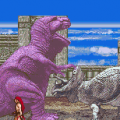- Rastan
- Rastan Saga II
- Warrior Blade: Rastan Saga Episode III
- Barbarian (PS2/GC)
While Rastan Saga II didn’t achieve the same success as the original, Taito took another stab at the franchise a few years later, this time turning it into a sidescrolling beat-em-up.
The premise again has no relation to the previous game. This time Rastan and his two companions travel to the land of Depon in search of treasures. Warrior Blade: Rastan Saga Episode III is something of a paradox. It has many advanced features from a mechanical standpoint, the most obvious of which being that it makes use of two arcade monitors set next to each other (just like Darius II and the X-Men arcade game) to create a very large play area. It also features exceptionally crisp background graphics for a 1991 game, as well as sprites that have a large variety of smooth animations. Like most beat-em-ups, the number of different enemy types is low, but Warrior Blade takes a cue from the original Rastan and has various combinations of armor and weapons, so a single type of enemy may appear differently to keep things interesting.
There are three playable characters (Rastan himself, a female warrior named Sofia, and an agile character named Dewey), each with different attributes. The game moves relatively fast for a 1991 beat-em-up, and is one of the few games of its kind of include some successful basic platforming. Your characters can run and also have a few special moves to get you out of a tight situation (including the ability to hit enemies that are already knocked down). Taito even added in some fast auto-scrolling levels where you may be flying upwards on a dragon or sliding down a mountain range.
The most interesting of these new features is that the character’s can pick up and use magic attacks similar to the Golden Axe series. Rather than just picking up and using potions, these attacks take the form of Rastan’s mysterious new ally, an ancient wizard named Mahadidekaradi. When you find him (by picking up a crystal ball from the ubiquitous breakable objects in the game’s levels), he follows you throughout the given level and a gauge representing his magic power is added to the bottom of the screen. Whenever you want, you can hit him, and he’ll use up some of his magic power to damage or defeat every enemy on the screen via a variety of very powerful spells. An impressive amount of detail is paid to these, as each one has not only a different animation, but a lengthy text incantation that flashes on the screen as your enemies are destroyed.
The paradox comes from the fact that, despite these advancements and the game’s obvious attempt to cash in on Final Fight, Warrior Blade‘s overall gameplay is firmly grounded in the old Technos beat-em-ups of the mid to late 80s. Instead of having pre-canned attack combos that result from hitting the attack button repeatedly, each character has a sizable number of context sensitive actions that are executed based on what position the enemy is in relation to your character.
These attacks can also be altered in some cases, depending on what direction you’re holding on the controller as you attack. This makes your characters rather versatile despite only having a single attack button. It also discourages brainless button mashing, since you need to wait for the right time to deal the ideal specialized attack to a given enemy, to prevent from being overwhelmed. If you’re cowardly though, you can outright run past many of the confrontations, though you’ll usually take extra damage this way.
On top of all this, the game even lets you choose which order you tackle its levels in. This seems irrelevant at first, however the game contains many bonus levels you can access based on your overall skill. Doing well in these levels bestows Rastan and his friends with items that permanently increase their abilities, or weaken their foes for the rest of the game. Depending on your skill, you can beat Warrior Blade by playing through as many as 14 levels.
The game’s presentation successfully evokes an atmosphere more interesting than most games of this kind. True to the nature of Robert E. Howard’s Conan stories, the bosses appear to be unstoppable demons, but all crumble and die very anti-climatically, with just a single scream as they become lifeless and fall apart. Rastan himself isn’t much of a hero, either, as he confronts these horrors solely to find all the treasures in the land. In an extra nod to this sort of build up, your character’s stance and move set changes slightly during boss fights.
The selectable stage order contributes to the sense of detachment, as it shows that Rastan cares not for the lands themselves or the people that populate them. His only interest is what money he can take from each region. In addition, the ending is something of a downer, hinting at the possibility of missed treasures and even a better ending, but these aren’t meant to be. Rastan simply travels onward to further adventures. Much like the story of the first game, Rastan’s motivations are purely mercenary, looking for wealth to satisfy immediate personal needs over all other things. So again, we have a Rastan ending that completely goes against the tone set by the previous release’s ending (Rastan defending the lands of “Rastania”).
Sadly, the game was never ported to consoles until its appearance amongst several other unsung gems on the Taito Memories series released in Japan from 2005 to 2007. Warrior Blade: Rastan Saga Episode III itself appears on Taito Memories II Gekan. It offers both a letterboxed 8:3 ratio, and a ridiculous looking 4:3 option, which squishes the picture horizontally to fit onto a standard SDTV screen.





















